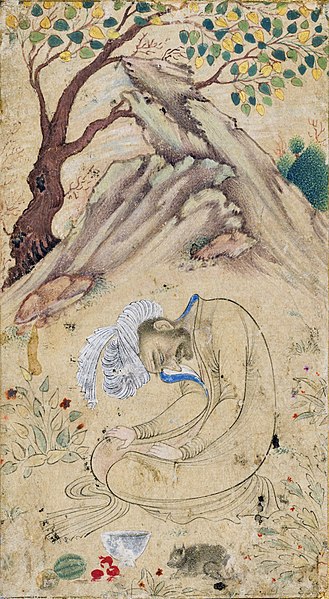Abū Yazīd Ṭayfūr bin ʿĪsā bin Surūshān al-Bisṭāmī (al-Basṭāmī), commonly known in the Iranian world as Bāyazīd Bisṭāmī, was a Persian Sufi from north-central Iran. Known to future Sufis as Sultān-ul-Ārifīn, Bisṭāmī is considered to be one of the expositors of the state of fanā, the notion of dying in mystical union with Allah. Bastami was famous for "the boldness of his expression of the mystic’s complete absorption into the mysticism." Many "ecstatic utterances" have been attributed to Bisṭāmī, which lead to him being known as the "drunken" or "ecstatic" school of Islamic mysticism. Such utterance may be argued as, Bisṭāmī died with mystical union and the deity is speaking through his tongue. Bisṭāmī also claimed to have ascended through the seven heavens in his dream. His journey, known as the Mi'raj of Bisṭāmī, is clearly patterned on the Mi'raj of the Islamic prophet Muhammad. Bisṭāmī is characterized in three different ways: a free thinking radical, a pious Sufi who is deeply concerned with following the sha'ria and engaging in "devotions beyond the obligatory," and a pious individual who is presented as having a dream similar to the Mi'raj of Muhammed. The Mi'raj of Bisṭāmī seems as if Bisṭāmī is going through a self journey; as he ascends through each heaven, Bisṭāmī is gaining knowledge in how he communicates with the angels and the number of angels he encounters increases.

Cover from a lacquer mirror case with multiple scenes, attributed to Mohammad Esmail Esfahani; the top scene depicts Bayazid Bastami and disciples. Created in Qajar Iran in the second half of the 19th century
Tomb of Bayazid Bastami in Bastam near Shahroud.
Bayazid Bastami's shrine in Chittagong, Bangladesh
Interior of Bayazid's Mosque
Sufism is a mystic body of religious practice found within Islam which is characterized by a focus on Islamic purification, spirituality, ritualism, asceticism, and esotericism.
Six Sufi masters, c. 1760
Dancing dervishes, by Kamāl ud-Dīn Behzād (c. 1480–1490)
A Sufi in Ecstasy in a Landscape. Isfahan, Safavid Persia (c. 1650–1660), LACMA.
A Mughal miniature dated from the early 1620s depicting the Mughal emperor Jahangir (d. 1627) preferring an audience with Sufi saint to his contemporaries, the Ottoman Sultan and the King of England James I (d. 1625); the picture is inscribed in Persian: "Though outwardly shahs stand before him, he fixes his gazes on dervishes."








